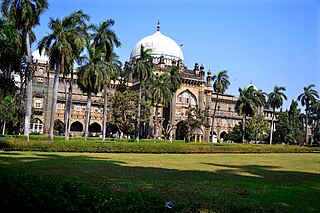
Chhatrapati Shivaji Maharaj Vastu Sangrahalaya, originally named Prince of Wales Museum of Western India, is a museum in Bombay (Mumbai) which documents the history of India from prehistoric to modern times.
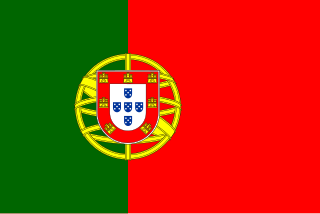
The State of India, also referred as the Portuguese State of India or simply Portuguese India, was a state of the Portuguese Empire founded six years after the discovery of a sea route to the Indian subcontinent by Vasco da Gama, a subject of the Kingdom of Portugal. The capital of Portuguese India served as the governing centre of a string of military forts and trade posts scattered all over the Indian Ocean.

Objet d'art literally means "art object" in French, but in practice, the term has long been reserved in English to describe works of art that are not paintings, large or medium-sized sculptures, prints, or drawings. It therefore covers a wide range of works, usually small and three-dimensional, of high quality and finish in areas of the decorative arts, such as metalwork items, with or without enamel, small carvings, statuettes and plaquettes in any material, including engraved gems, hardstone carvings, ivory carvings and similar items, non-utilitarian porcelain and glass, and a vast range of objects that would also be classed as antiques, such as small clocks, watches, gold boxes, and sometimes textiles, especially tapestries. Books with fine bookbindings might be included.
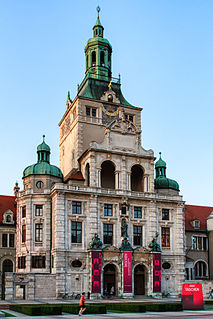
The Bavarian National Museum in Munich is one of the most important museums of decorative arts in Europe and one of the largest art museums in Germany. Since the beginning the collection has been divided into two main groups: the art historical collection and the folklore collection.

The National Museum in New Delhi, also known as the National Museum of India, is one of the largest museums in India. Established in 1949, it holds a variety of articles ranging from pre-historic era to modern works of art. It functions under the Ministry of Culture, Government of India. The museum is situated on Janpath. The blue–print of the National Museum had been prepared by the Gwyer Committee set up by the Government of India in 1946. The museum has around 200,000 works of art, mostly Indian, but some of foreign origin, covering over 5,000 years.

The Xavier Centre of Historical Research is a Jesuit history research centre located in Alto Porvorim, Goa in India. It was founded in the late 1970s and its first director was John Correia Afonso SJ. After John Correia Afonso, Dr. Teotonio R. de Souza was the next director of the Centre (1979–1994). Charles Borges SJ who had served as Administrator and Associate Director, took over the direction of XCHR until the year 2000, when he left for Maryland College in Baltimore as its faculty staff. He was succeeded by Delio Mendonca, SJ and Savio Abreu, SJ. The present director is Anthony da Silva SJ. It is a prominent institution in Asia for its focus on Indo-Portuguese issues, and besides organising seminars and talks, it also publishes a number of books related to the Portuguese in India and Asia, Goa, the Jesuits and other historical themes. A few years ago, the focus of the institute was expanded to study Jesuit History of the Society of Jesus in South Asia. It has set up an art gallery.

The state of Goa, in India, is famous for its beaches and places of worship. Tourism is its primary industry, and is generally focused on the coastal areas of Goa, with decreased tourist activity inland.

The Cathedral Treasure or Sacred Art Museum is a museum incorporated in the Braga Cathedral in Braga, Portugal.
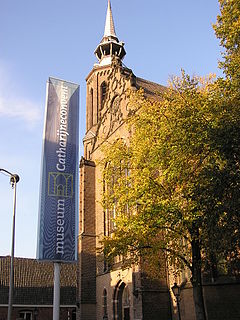
The Museum Catharijneconvent is a museum of religious art in Utrecht, Netherlands. It is located in the former St. Catharine convent, having been sited there since 1979. Its collections include many artifacts from the museum of religious art of the Catholic Archbishopric of Utrecht, located in the convent until 1979. In 2006 the convent closed for restoration. It is part of the Utrecht Museum Night.
Jatin Das is an Indian painter, sculptor and muralist. He is counted amongst the most contemporary artists of India.

The Our Lady of the Immaculate Conception Church is located in Panjim, Goa, India. The Church conducts Mass every day in English, Konkani, and Portuguese.
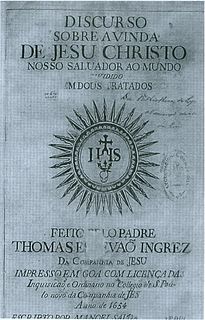
Krista Purana is an epic poem on the life of Jesus Christ written in a mix of Marathi and Konkani by Fr.Thomas Stephens, S.J. (1549–1619). Adopting the literary form of the Hindu puranas, it retells the entire story of mankind from the creation days to the time of Jesus, in lyrical verse form. The Christian Puranas – 11,000 stanzas of 4 verses – were very popular in the churches of the area where they were sung on special occasions up to the 1930s. Although no copy of the original edition has yet been discovered, it is believed to have been published at Rachol (Raitur) in 1616, 1649, and 1654.

Goa State Museum, also known as the State Archaeology Museum, Panaji, is a museum in Goa, India. Established in 1977, it contains departments including Ancient History and Archaeology, Art and Craft, and Geology. The museum, as of 2008, had about 8,000 artifacts on display, including stone sculptures, wooden objects, carvings, bronzes, paintings, manuscripts, rare coins, and anthropological objects. Currently, the Museum is located at the Adil Shah's Palace in Panaji. The Museum's erstwhile premises at the EDC Complex in Patto, Panaji shall be demolished to make way for a new Museum building.

The National Gandhi Museum or Gandhi Memorial Museum is a museum located in New Delhi, India showcasing the life and principles of Mahatma Gandhi. The museum first opened in Mumbai, shortly after Gandhi was assassinated in 1948. The museum relocated several times before moving to Raj Ghat, New Delhi in 1961.

The Rachol Seminary, also known today as Patriarchal Seminary of Rachol, is the diocesan major seminary of the Primatial Catholic Archdiocese of Goa and Daman in Rachol, Goa, India.
Angelo da Fonseca (1902-1967) was a 20th-century Indian painter.

The National Museum in New Delhi, India, has two galleries of decorative arts with a large collection of Mughal jade carvings forming a display for its Jade Collection.

Laxman Pai was an Indian artist and painter. He was a principal of the Goa College of Art, a post he held from 1977 to 1987. Pai was a recipient of several awards including India's third highest civilian honour of Padma Bhushan, awarded by the Government of India.
Teresa Albuquerque was an Indian historian who specialised in the Goan diaspora and the colonial history of Bombay.

Angela Trindade was an Indian painter famous for her Western-style portraits and Christian paintings in Indian style. A versatile artists, she also development of her own style, Trindadism, wherein the artist used the symbolic dimensions of the triangle and of trinity that conferred upon Angela a real individual approach to art.

















